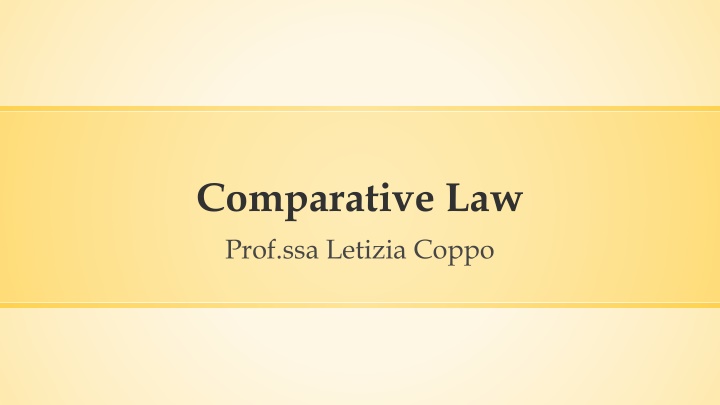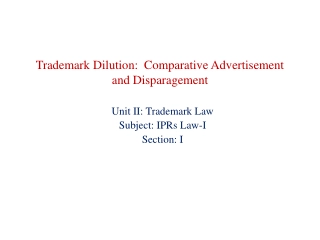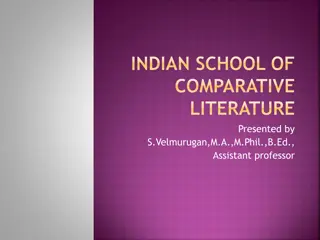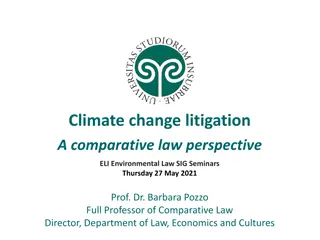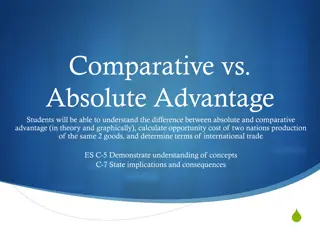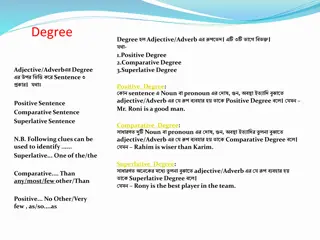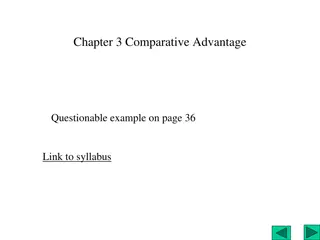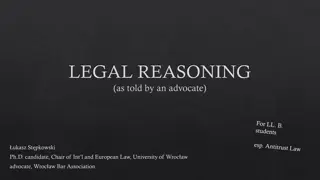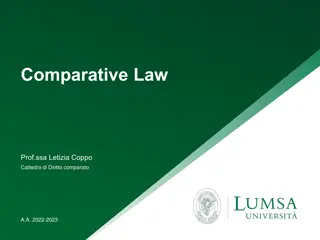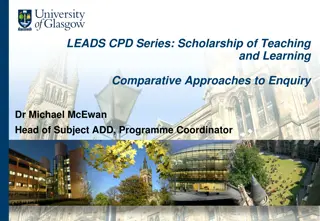Legal Families of the World: Comparative Analysis
This study delves into the classification of legal systems into distinct families based on common features, examining various criteria such as historical sources, system structure, and ideological foundations. The challenges and fluid nature of categorizing legal systems are explored, highlighting the complexities of such divisions in a global context.
Download Presentation

Please find below an Image/Link to download the presentation.
The content on the website is provided AS IS for your information and personal use only. It may not be sold, licensed, or shared on other websites without obtaining consent from the author.If you encounter any issues during the download, it is possible that the publisher has removed the file from their server.
You are allowed to download the files provided on this website for personal or commercial use, subject to the condition that they are used lawfully. All files are the property of their respective owners.
The content on the website is provided AS IS for your information and personal use only. It may not be sold, licensed, or shared on other websites without obtaining consent from the author.
E N D
Presentation Transcript
Comparative Law Prof.ssa Letizia Coppo
THE LEGAL FAMILIES OF THE WORLD Key questions 1. Can we divide the vast number of legal systems into groups? 2. What for? 3. How do we decide what such groups should be? 4. How do we decide whether a system belongs to one or another group? 5. What if some systems fall into more than one group?
THE LEGAL FAMILIES OF THE WORLD From groups to legal families: systems can be divided into legal families because it is possible to identify some common features among them, depending on the perspective from which ones looks at them. Reasons for legal families: the need to simplify complexity: if we identify the system that is more representative of a certain group, then it will be easier to understand the features of the other systems belonging to the family.
HOW DO WE DECIDE WHAT THE LEGAL FAMILIES SHOULD BE? The answer depends upon several factors, among which the perspective from which we want to analyse a certain system and the criterion we choose. ESMEIN s classification Criteria: historical sources, general structure and peculiarities. Families: Romanistic, Germanic, Anglo-Saxon, Slav and Islamic
HOW DO WE DECIDE WHAT THE LEGAL FAMILIES SHOULD BE? ARMINJON-NOLDE-WOLFF s classification Criterion: the substance of each system, i.e. originality, deviation and common elements, without any reference to extrinsic factors such as geography or race. Families: French, German, Scandinavian, English, Russian, Islamic and Hindu.
HOW DO WE DECIDE WHAT THE LEGAL FAMILIES SHOULD BE? REN DAVID s classification Criteria: ideology (i.e. the product of religion, philosophy or political-economic or social structure) and legal technique (mainly the philosophical basis or the conception of justice). Families: Romanistic-German; common law, socialist, and other systems (Jewish, Hindu, Far East).
CRITICALITIES OF THE DIVISION IN LEGAL FAMILIES It is unclear which qualities are distinctive of each system. There are parents systems and affiliate ones, but the inclusion in one or the other category is a slippery task. Classifications in legal families are necessarily temporary: they may change following reforms or other events (wars, colonisation ). And that is why it has been argued that historical development should not be the paramount criterion but should be replaced with the question whether the systems have the same legal culture, i.e. their citizens have similar attitudes towards law and similar expectations.
CRITICALITIES OF THE DIVISION IN LEGAL FAMILIES The abovementioned classifications are focused on the private law system. They may be helpless in the comparison of other branches of the law (e.g. German private law belongs to the German legal family, but constitutional law looks like the one of the Italian and North American families, according to the criterion of the judicial review). They may not be valid for all branches of private law (e.g. in Islamic countries, family and inheritance law belongs to the Islamic tradition, but economic law is modelled on the law of colonisers.
THE CONCEPT OF LEGAL STYLE The crucial issue is to grasp the legal style of the systems, i.e. the distinctive element, the essential and differentiating qualities. Possible hints of the legal style of systems 1. Historical background and development 2. Predominant and characteristic 3. Especially distinctive institutions 4. The kind of legal sources it acknowledges and the way it handles them 5. Its ideology
I. HISTORICAL BACKGROUND AND DEVELOPMENT Continental systems all stem from Roman and Germanic law, but subsequent events have obliterated the significance of the common origins: great movement of reception to which the French Code civil gave rise (which did not involve German-speaking countries); development in XIX century in German-speaking countries of a formal legal technique based on elaborated and clear concepts (Pandettistica). That is why we separate the Romanistic family from the Germanic one.
II. DISTINCTIVE WAY OF THINKING Germanic-romanistic families Tendency to use abstract legal norms Common law families Empiricist approach, i.e. learning by experience, rather than making plans or drafting rules in advance and systematise them Tendency to have a well-articulated system organised in well-defined areas of the law Theorising has little appeal Tendency to think up and think in juristic construction Case-law rather than legislation (but see EU law, UCTA, UCC )
II. DISTINCTIVE WAY OF THINKING Germanic-romanistic families Law comes from study, universities and great jurists were professors Common law families Law comes from courts and great jurists were judges Lawyers faced with a practical problem wonder what is the solution provided by the law Lawyers predict what the decision of courts would be, on the basis of precedents Lawyers think abstractly in terms of institutions, by ideas, delight in systematics Lawyers think in terms of cases and are sceptical generalisation of whatever
DISTINCTIVE WAY OF THINKING The struggle for law : R. VON JHERING suggested this additional criterion, referring to the propensity of people from a certain system to fight for their rights. E.g.: in Far-East Countries law is a secondary and subordinate means of achieving social order and it is used only as the last resort. The harmony of society is a reflection of the cosmic harmony and unwritten rules of behaviour are harmoniously integrated by tradition. People prefer settlement to litigation; no I win, you loose logic, but importance of saving the opponent s reputation (see annex A)
III/IV. DISTINCTIVE LEGAL INSTITUTIONS AND SOURCES Distinctive legal institutions: each system has some peculiar institutions that are stranger to the original conceptual apparatus of other systems and often cannot even be translated into other languages (e.g. trust; causa; culpa in Gesch ftsgrundlage or caduta della presupposizione; Schutzpflichten or obblighi di protezione). contrahendo; Wegfall der Sources of law and methods for handling with them: see the traditional (but exaggerated) opposition between statutory law systems and case-law systems; statutory hermeneutics and the doctrine of precedents.
V. IDEOLOGY Meaning: a religious or political conception of how social or economic life should be organised. Instances: it is a legal formant in Islamic, Hindu and socialist families. Warning: ideology is a relative criterion, i.e. it is not useful for the distinction among the families belonging to the European or Western tradition. It can be used only for systems in which religion or political ideas infuse the law.
HYBRID SYSTEMS Warning: the weigh to be given to all the mentioned factors varies according to the circumstances. Sometimes systems are in transition, i.e. in the process of moving towards a particular legal family. There are systems which, though not in transition, consist of a mixture of families; in some areas they bear the imprinting of one parent system, in other areas of a different parent: e.g. Scotland, Quebec, South Africa; Louisiana; Israel, Republic of China. Legal families are a READY but ROUGH device!
LEGAL FAMILIES OF THE WORLD: CONCLUSIVE REMARKS Ren David: Legalfamilies do not exist like human families: the idea is used purely for explanatory purposes, to indicate the extent of difference and similarity in the various legal systems. It follows that all classifications have their utility: it all depends upon the point of view adopted by the writer in question and the aspects of the matter which interests him most.
OUR LEGAL FAMILIES Romanistic family Germanic family Nordic family Common law family People s Republic of China Japanese law Islamic law Hindu law
